Samuel John "Lamorna" Birch, RA, RWS was an English artist in oils and watercolours. At the suggestion of fellow artist Stanhope Forbes, Birch adopted the soubriquet "Lamorna" to distinguish himself from Lionel Birch, an artist who was also working in the area at that time.
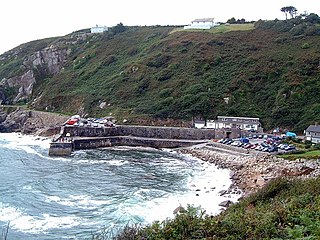
Lamorna is a village, valley and cove in west Cornwall, England, UK. It is on the Penwith peninsula approximately 4 miles (6 km) south of Penzance. Lamorna became popular with the artists of the Newlyn School, including Alfred Munnings, Laura Knight and Harold Knight, and is also known for former residents Derek and Jean Tangye who farmed land and wrote "The Minack Chronicles".
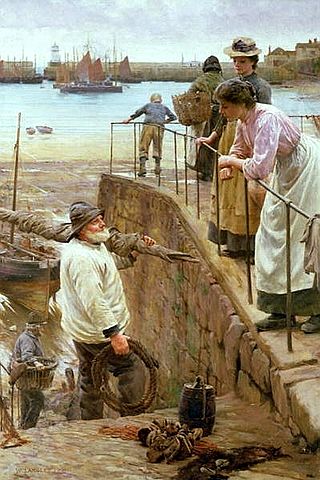
The Newlyn School was an art colony of artists based in or near Newlyn, a fishing village adjacent to Penzance, on the south coast of Cornwall, from the 1880s until the early twentieth century. The establishment of the Newlyn School was reminiscent of the Barbizon School in France, where artists fled Paris to paint in a more pure setting emphasising natural light. These schools along with a related California movement were also known as En plein air.

Penzance is a town, civil parish and port in the Penwith district of Cornwall, England, United Kingdom. It is the most westerly major town in Cornwall and is about 64 miles (103 km) west-southwest of Plymouth and 255 miles (410 km) west-southwest of London. Situated in the shelter of Mount's Bay, the town faces south-east onto the English Channel, is bordered to the west by the fishing port of Newlyn, to the north by the civil parish of Madron and to the east by the civil parish of Ludgvan. The civil parish includes the town of Newlyn and the villages of Mousehole, Paul, Gulval, and Heamoor. Granted various royal charters from 1512 onwards and incorporated on 9 May 1614, it has a population of 21,200.

Newlyn is a seaside town and fishing port in south-west Cornwall, England, United Kingdom. It is the largest fishing port in England.
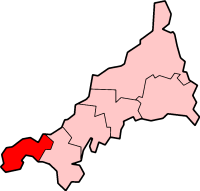
Penwith is an area of Cornwall, England, located on the peninsula of the same name. It is also the name of a former local government district, whose council was based in Penzance. The area is named after one of the ancient administrative hundreds of Cornwall which derives from two Cornish words, penn meaning 'headland' and wydh meaning 'at the end'.

Mousehole is a village and fishing port in Cornwall, England, UK. It is approximately 2.5 miles (4 km) south of Penzance on the shore of Mount's Bay. The village is in the civil parish of Penzance. An islet called St Clement's Isle lies about 350 metres (380 yd) offshore from the harbour entrance.
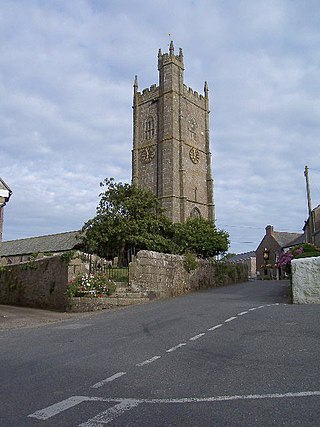
Paul is a village in Cornwall, England, United Kingdom. It is in the civil parish of Penzance. The village is two miles (3 km) south of Penzance and one mile (1.6 km) south of Newlyn.
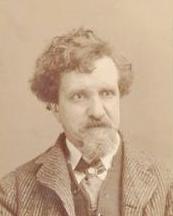
John Noble Barlow (1861–1917) was a prominent English artist at the turn of the twentieth century, known predominantly as a landscape and seascape painter.
Noel Betowski is an artist living and working in Cornwall.

Penlee House is a museum and art gallery located in the town of Penzance in Cornwall, and is home to a great many paintings by members of the Newlyn School, including many by Stanhope Forbes, Norman Garstin, Walter Langley and Lamorna Birch. Penlee House is currently operated by Penzance Town Council in association with Cornwall Council. Well-known works from the renowned Newlyn School include The Rain It Raineth Every Day by Norman Garstin, School is Out by Elizabeth Forbes, Among the Missing by Walter Langley and On Paul Hill by Stanhope Forbes.
Paul Feiler was a German-born artist who was a prominent member of the St Ives School of art: he has pictures hanging in major art galleries across the world.

Harold Harvey (1874–1941) was a Newlyn School painter who painted scenes of working-class Cornish fishermen, farmers and miners and Cornish landscapes. He was born in Penzance and trained at the Penzance School of Arts under Norman Garstin and the Académie Julian in Paris (1894–1896).
Annie Walke or Anne Fearon Walke was an English artist. Anne Fearon grew up and was schooled in Banstead, Surrey. After completing her studies at the Chelsea School of Art and the London School of Art, she and her sister, Hilda Fearon, furthered their studies in Dresden, Germany. About the turn of the 20th century Miss Fearon settled in Cornwall, where she continued her studies and established a studio in the Cornish coastal village of Polruan. After she married Nicolo Bernard Walke in 1911, she soon moved with him to St Hilary, Cornwall. where her husband became the vicar in 1913. She was a member of the Newlyn School and other artists' organizations and created portraits and religious works for churches. Her work has been exhibited in England, Paris, America and South Africa. In the latter part of her life Walke was a published poet.

Jack Pender (1918–1998) was a British artist.
Eleanor Mary Hughes, was a New Zealand landscape artist who mostly painted in watercolours. She settled and worked in Britain and became an active member of the Newlyn School of artists and the nearby Lamorna artists colony.
Ruth Simpson was a British artist who was an active member of the Newlyn School of artists and the Lamorna artists colony.

Marjorie Frances Bruford known as Midge Bruford was a British artist associated with the Newlyn School of artists. Although born in Eastbourne, Bruford was an active participant in several of the artist groups based in Cornwall throughout her adult life.

Albert Reuss was an Austrian-born British painter and sculptor. He was born in Vienna and fled to Britain in 1938 following the Anschluss, Adolf Hitler’s annexation of Austria to the German Reich. In the process, Reuss lost many members of his family, and the reputation he had built up as an artist in Vienna. He continued to work as an exiled artist, but his style changed dramatically, reflecting the trauma he had suffered. Many public collections in Britain hold his work, most notably Newlyn Art Gallery in Cornwall, the British Museum and the Victoria and Albert Museum in London, the Österreichische Galerie Belvedere and the Albertina both in Vienna, and the Tel Aviv Museum of Art in Israel.














